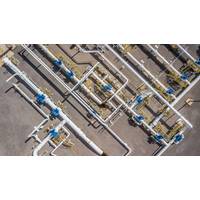Port Technology: 3 Ways Propane Equipment Boosts Productivity, Bottom Line

The Author: Matt McDonald is the director of off-road business development at the Propane Education & Research Council.
Propane port-side equipment offers superior performance, versatility
The relationship between U.S. ports and America’s economic vitality is undeniably important. Martin Associates, a leading provider of economic and strategic assessments of the world’s transportation systems, analyzed the economic impact of U.S. seaports in a 2018 study, revealing just how critical port operations are.
According to the firm’s 2018 National Economic Impact of the U.S. Coastal Port System report, the total economic value that U.S. coastal ports provide in terms of revenue to businesses, personal income, and economic output by exporters and importers increased 17 percent between 2014 and 2018 — from $4.6 trillion to $5.4 trillion. This accounted for nearly 26 percent of the nation’s $20.5 trillion economy in 2018.
Seeing these statistics, it’s no surprise that marine terminals are dynamic environments, constantly moving containers and other heavy bulk loads. The loading and unloading of ships require a variety of material handling equipment, and crews need reliable, efficient equipment to help them handle growing cargo volumes. Fortunately, propane-powered equipment offers a few key advantages compared with other options, making it an ideal energy source for ports.
- 1. Propane offers true versatility.
Port-side crews are consistently busy loading, unloading, and transporting materials each day, which is why the last thing they want to worry about is having to juggle multiple fuels to complete different types of tasks. Fortunately, propane provides a go-to energy solution, powering on- and off-road vehicles and land- and sea-side applications. More specifically, propane can power forklifts, light- and medium-duty vehicles, port and terminal tractors, shuttles, and small marine vessels.
Plus, propane can support employees needing to operate equipment both indoors and out, whereas gasoline and diesel equipment aren’t fit for indoor use. Propane forklifts, for example, can safely operate in properly-ventilated indoor spaces, thanks to the equipment’s low-emissions profile. Well-maintained propane forklifts actually meet or exceed nationwide indoor air quality standards, whereas gasoline and diesel can produce higher amounts of carbon monoxide and other harmful emissions.
- 2. Propane equipment is trusted for reliable performance.
Whether it’s being used to drive a work truck throughout the port or to unload pallets from a shipment, propane provides crews with the power they need to accomplish virtually any task.
Propane forklifts don’t lose power throughout the workday and maintain 100 percent power throughout operation, unlike electric models. According to data from the Propane Education & Research Council (PERC), propane-powered forklifts push heavy loads at full capacity faster and longer than electric forklifts.
Data from PERC also notes that a typical propane autogas vehicle can drive farther on a full tank than a comparable electric vehicle can drive on a full charge. And because propane is completely gaseous when it enters the engine, propane autogas vehicles are easier to start in cold weather than gasoline and diesel vehicles — which is specifically beneficial for ports located in regions that experience colder temperatures in winter months.
- 3.Crews can rely on quick, easy refueling.
Whether in large operations or smaller fleets, propane equipment provides the quick refueling needed to keep material moving. With propane forklifts, for example, crews can work an entire eight-hour shift on one full cylinder and when the cylinder is empty, they can simply swap it out for a full one and continue working. Forklift operators don’t have to schedule downtime for recharging, like with electric equipment. Additionally, ports operating propane equipment can set up a tailored refueling schedule with their local propane supplier to ensure that their propane cylinder cages are always full.
And with propane autogas vehicles, the quick-connect nozzle provides a simple, convenient refueling experience which requires minimal downtime, allowing employees to get back to work promptly. With electric vehicles using a standard charger, vehicles require eight to 10 hours to reach a full charge and express chargers require 1.6 hours to reach a full charge. For comparison, a fleet of 10 propane autogas vehicles can refuel from a single hose in just over two hours. Recharging a fleet of 10 electric vehicles in the same time frame would require separate charging stations for every one or two vehicles.
Terminal managers, next time you’re looking for ways to boost productivity, consider the energy sources being used to power port equipment. In addition to propane’s key operational benefits, propane-powered equipment can also support port’s sustainability efforts and comply with environmental regulations, as well as cut down on operational costs.
To learn more about the benefits of port-side propane equipment, visit Propane.com/Ports.


